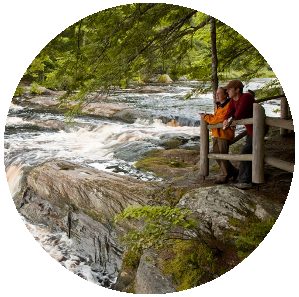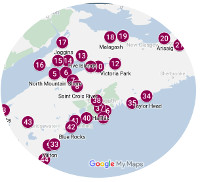- Why Mining Matters
- Jobs
- Safety
- Environment & Operations
- FAQ
- Links
- Fun Stuff
Kejimkujik National Park
Kejimkujik National Park and its seaside adjunct are excellent places to see how glaciers have helped shape Nova Scotia.
Kejimkujik has many features that resulted from Nova Scotia’s last glacial period, which ended about 11,000-13,000 years ago in that area. The glaciers left numerous shallow lakes in depressions created by glacial erosion. Huge boulders of granite, called erratics, are scattered all over because glaciers carried and later dropped the boulders.

There are drumlins, smooth, oval hills created by glacial till. They have steeper, blunt ends facing the oncoming glacier, and a gentle slope pointing in the direction of glacial retreat. They are basically shaped like an inverted spoon. In the Park the drumlins point from the northwest to the southeast which tells us that this is the direction in which the glaciers moved.
The park is underlain by two main types of rock; a granite terrane and a sedimentary terrane comprised of slate and quartzite. The hard granite areas are higher because they were more resistant to erosion and softer sedimentary areas are lower and more level as a result of glacial erosion.
Glaciation has stripped away ancient soils and left a blanket of thin, patchy till, with rounded drumlins dotting the land. In the Seaside Adjunct the mixture of the granites and quartzites is clearly shown in exposed rock outcrops while the till layer is extremely thin and poorly drained.
Kejimkujik is a stark but beautiful area with a fascinating geological history.
Further reading: https://www.pc.gc.ca/en/pn-np/ns/kejimkujik/nature/environnement-environ...




























































































